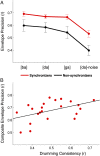Beat synchronization predicts neural speech encoding and reading readiness in preschoolers
- PMID: 25246562
- PMCID: PMC4210020
- DOI: 10.1073/pnas.1406219111
Beat synchronization predicts neural speech encoding and reading readiness in preschoolers
Abstract
Temporal cues are important for discerning word boundaries and syllable segments in speech; their perception facilitates language acquisition and development. Beat synchronization and neural encoding of speech reflect precision in processing temporal cues and have been linked to reading skills. In poor readers, diminished neural precision may contribute to rhythmic and phonological deficits. Here we establish links between beat synchronization and speech processing in children who have not yet begun to read: preschoolers who can entrain to an external beat have more faithful neural encoding of temporal modulations in speech and score higher on tests of early language skills. In summary, we propose precise neural encoding of temporal modulations as a key mechanism underlying reading acquisition. Because beat synchronization abilities emerge at an early age, these findings may inform strategies for early detection of and intervention for language-based learning disabilities.
Keywords: auditory processing; cABR; rhythm; speech envelope; temporal processing.
Conflict of interest statement
The authors declare no conflict of interest.
Figures


References
-
- Felsenfeld S, Broen PA, McGue M. A 28-year follow-up of adults with a history of moderate phonological disorder: Educational and occupational results. J Speech Hear Res. 1994;37(6):1341–1353. - PubMed
-
- Démonet J-F, Taylor MJ, Chaix Y. Developmental dyslexia. Lancet. 2004;363(9419):1451–1460. - PubMed
-
- Ramus F, Hauser MD, Miller C, Morris D, Mehler J. Language discrimination by human newborns and by cotton-top tamarin monkeys. Science. 2000;288(5464):349–351. - PubMed
-
- Eimas PD, Siqueland ER, Jusczyk P, Vigorito J. Speech perception in infants. Science. 1971;171(3968):303–306. - PubMed
Publication types
MeSH terms
Grants and funding
LinkOut - more resources
Full Text Sources
Other Literature Sources

